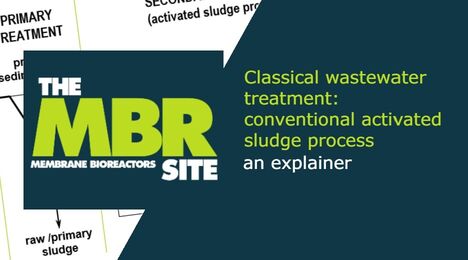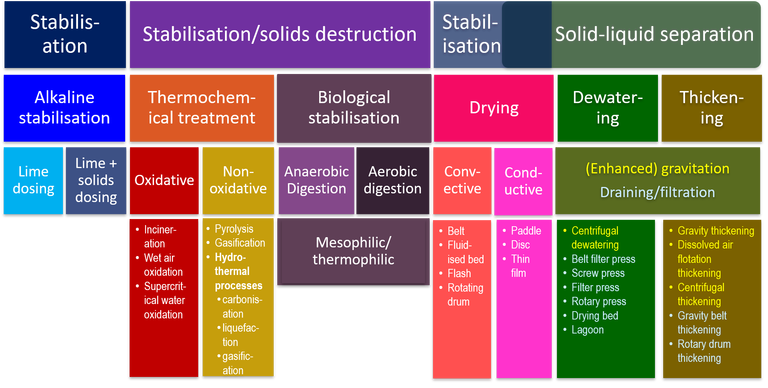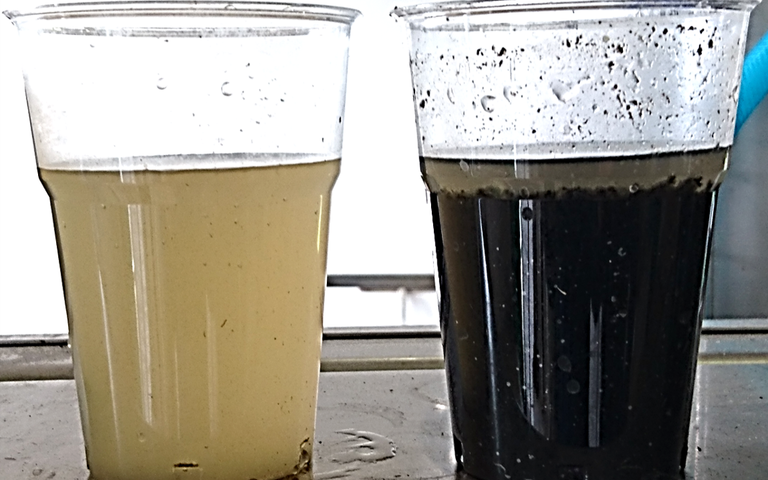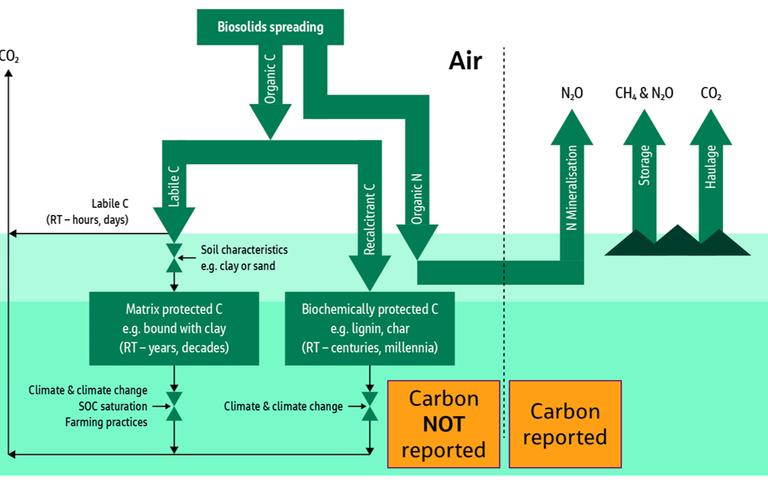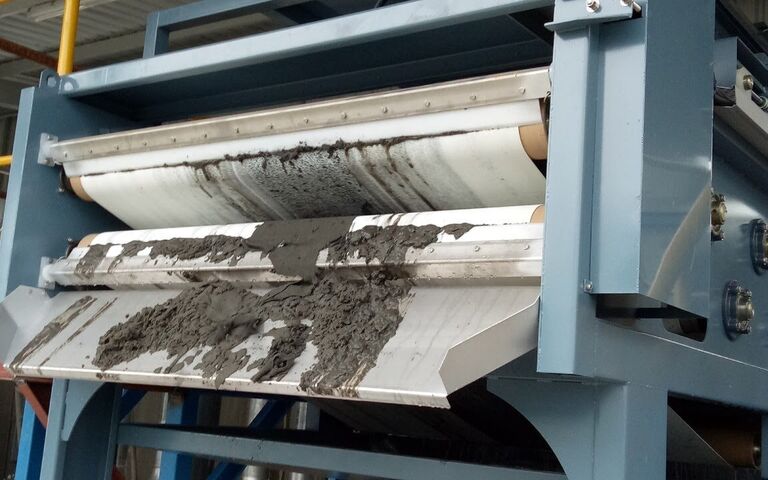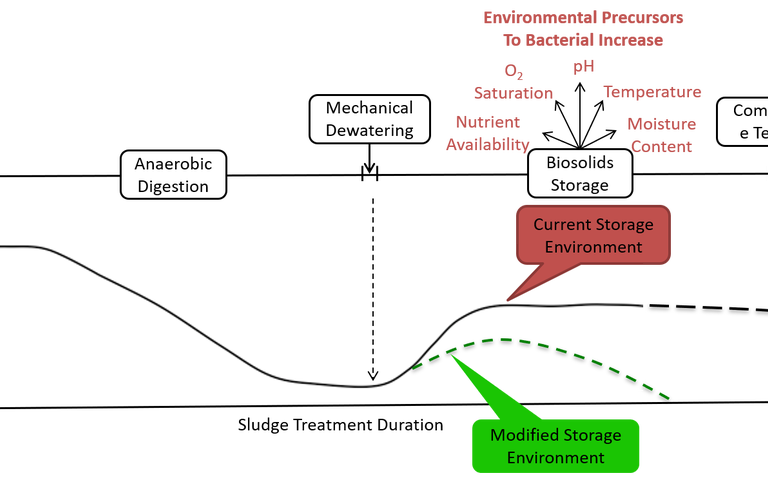What is sludge treatment?

Overview of sludge processing
Sludge is the main waste stream generated from water purification, both water for drinking and wastewater for environmental discharge. It requires processing to reduce:
- its volume, and so the cost of subsequent haulage and disposal,
- the risk it poses to public health, primarily from the pathogenic micro-organism content,
- its odour,
- its putrescence (i.e. the decay of the organic matter), and/or
- its instability, such as the leaching of toxic or otherwise harmful components.
The sludge characteristics depend on both the original feedwater quality and the type of the unit operation from which the sludge is discharged. For conventional municipal wastewater treatment, the two principal sludge streams are:
- from the primary sedimentation stage, producing primary sludge, and
- the secondary biological treatment stage, producing waste activated sludge (WAS) if the biological treatment is based on the activated sludge process [links to The MBR Site].
Regardless of its origins, sludge contains water, dissolved organic and inorganic materials and suspended solids. The suspended solids normally make up 2−5% of the sludge for municipal wastewater sludge.
The organic solids component of the sludge, quantified as the volatile solids (VS) content, is normally considered to be the most directly useful. These solids are referred to as biosolids and can be used as soil fertilisers or else their latent energy recovered by conversion to heat or a useful fuel (or biofuel).
Sludge processing methods
There are essentially two methods by which the volume of sludge is reduced:
- consolidation, which reduces the sludge volume by removing the water along with the associated dissolved solids, and
- destruction, in which the organic carbon component of the sludge is either oxidised, ultimately to carbon dioxide, or reduced, predominantly to methane.
Sludge processing: the basics
Sludge consolidation processes can be categorised as either thickening or dewatering, depending on the extent of water removal. Thickened sludge retains the free-flowing liquid-like properties of sludge. Dewatered sludge (called cake) has a higher suspended solids concentration. The cake does not flow like a liquid and so cannot be pumped. It must instead be conveyed by a conveyor belt, Archimedean screw, or mechanical earth-moving equipment such as a front loader.
Water is removed from sludge by:
- allowing the solids to settle or encouraging them to float and removing the resulting clarified supernatant water,
- allowing the water to drain from the solids through a porous retaining material, or else forcing the water from the sludge under pressure through the porous material,
- enhancing the effect of gravity by centrifugation to separate the solids from the water, or
- evaporating the water.
Water removal is made easier by modifying the sludge through chemical or thermal treatment. These treatment processes are referred to as sludge conditioning, and act by changing the size and/or other characteristics of the sludge suspended solids.
Sludge process types Credit: Judd Water & Wastewater Consultants Sludge process types 
The simplest consolidation method is gravitation (also called sedimentation), an example of a thickening process. In gravity thickening, the solids are allowed to settle and the supernatant liquid removed, reducing the sludge volume as a result. Solids may also be encouraged to float and removed by a skimmer, as in a dissolved air flotation thickener. Thickening by draining can be achieved with either a rotary drum or a gravity belt thickener.
Centrifugation can be employed both to thicken and dewater sludge, depending on whether or not a free-flowing, pump-able product is required. Dewatering technologies are otherwise all based on enhanced draining/filtration and comprise:
Finally, dewatering can also be achieved using large-footprint, low-energy, low-tech (or ‘natural’) processes. These comprise drying beds and lagoons which remove water predominantly by draining and evaporation respectively.
Mechanical removal of water by dewatering processes cannot generally achieve solids concentrations of more than ~40%. If further water removal is required, thermal drying is employed.
There are two different dryer types: convective and conductive. Convective dryers (sometimes called direct dryers) provide heating by heating the ambient air in the dryer. Conductive (or indirect) dryers heat the sludge by contacting the sludge particles with an externally-heated surface.
Some key sludge processing methods are intended to stabilise the sludge. Sludge stabilisation processes are those which reduce/eliminate its odour, putrescence (i.e. it’s tendency to decay) and its pathogenic (disease-causing) micro-organism content. This can be achieved chemically (through lime dosing), biologically, or physically (by applying/generating heat).
Stabilised sludge may then be either safely disposed of, or reused either in part (i.e. its more valuable constituents extracted) or in total.
Stabilisation through chemical dosing (specifically lime dosing) does not reduce the sludge volume. All other methods which are termed ‘stabilisation’ either substantially reduce the water content (thermal drying), or else thermally or biologically degrade the organic matter (thermochemical and digestion processes respectively). Both biological and thermochemical treatment can be carried out in the presence or absence of oxygen, and both effectively stabilise the sludge. Both treatment types also recover a useful resource in the form of either a combustible gas or thermal energy directly.
Biological stabilisation in the absence and presence of oxygen is respectively referred to as:
These methods can both be conducted at under moderate (mesophilic) or elevated (thermophilic) temperature conditions.
Thermochemical methods include the oxidative processes of:
- incineration
- wet oxidation (or wet air oxidation, WAO), and
- supercritical water oxidation (SCWO)
as well as the non-oxidative (or partial-oxidative) processes:
- pyrolysis
- gasification, and
- hydrothermal treatment.
Wet air oxidation and hydrothermal processes can be conducted in the presence of water, whereas the other processes require a substantially dry product. Gasification operates under restrictive oxidative conditions, as opposed to the fully oxidative conditions of incineration, WAO and SCWO.
Sludge as a resource
While sludge is essentially a waste product, there is increasing focus on its potential as a resource (i.e. sludge valorisation), specifically with reference to its:
- latent energy (or calorific content, which can be used to quantify its potential for methane and/or hydrogen production), and
- nutrient content (phosphate and nitrate).
There is also significant interest in, and increasing implementation of, its combination with other wastes to aid its processing and overall efficiency (co-treatment or co-disposal).

